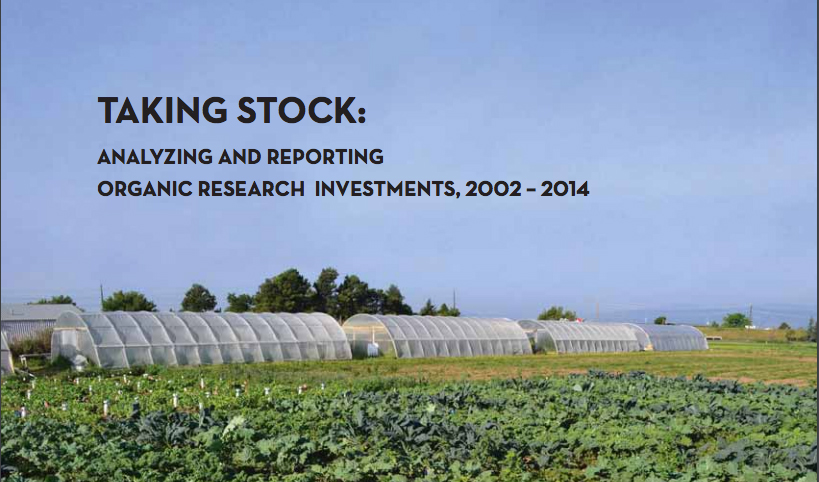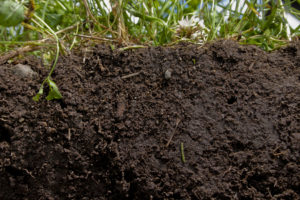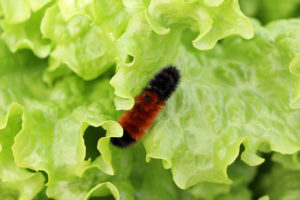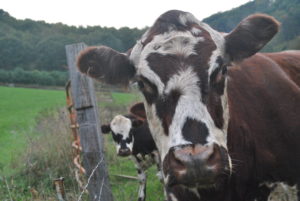
Research is the unsung hero underpinning every aspect of successful farming. For hundreds of years farmers have driven their own research, sharing their knowledge and experience with one another and passing down tips and techniques through the generations. Today we live in an increasingly connected world, one in which farmers are no longer limited by geography – they can now not only get data from their neighbors, but from top agroecologists and scientists from across the nation.
There is an enormous possibility to create better, more sustainable agricultural systems through the sharing of data and research. While we have the tools, however, we still lack the means to adequately serve farmers. Public seed and breeding (“seeds and breeds”) research, including for organic farming, is woefully underfunded. Lack of public investment in seeds and breeds research has left many organic farmers without the information, services, and resources they need to successfully compete in a quickly growing industry.
The systematic ignoring of the need for publicly funded research in our country’s fastest growing agricultural sector prompted the Organic Farming Research Foundation (OFRF), an NSAC member organization, to take a closer look at the role public investments have played in the organic industry to date. OFRF recently released their findings in the report, Taking Stock: Analyzing and Reporting Organic Research Investments, which offers an unprecedented assessment of the impact investments from the U.S. Department of Agriculture (USDA) have made in addressing critical research needs of organic farmers. The report also provides recommendations for key areas in which future research investments should be targeted.
Why Invest in Organic Research?
As one of the fastest growing agricultural sectors in the United States, organic agriculture plays an important role in the U.S. economy. According to data from the Organic Trade Association, in 2015 the organic industry grew to $43.3 billion in sales (up 11 percent from 2014); non-organic food sales, by comparison, only grew by three percent.

Although consumer demand for organics has continued to steadily grow, federal investments in research for organic farming systems have failed to keep pace. With sales of organic products projected to increase by 12-15 percent annually for the next several years, ensuring our farmers have the information, research, and seed stocks they need to match production demands is increasingly critical.
Historically, land grant universities (state-run education institutions that are supported in part with federal funds in order to promote educational opportunities in agriculture research and science) worked closely with farmers in their region to develop crop seeds and animal breeds tailored to meet local growing conditions. Today, however, the advent of genomics and other, more expensive breeding technologies has led to the patenting and consolidation of crop seed stocks by an increasingly small number of private seed companies. Because federal investments have failed to keep public research and seed breeding institutions viable, farmers now lack access to seed stocks uniquely tailored to their climate and growing needs. This is particularly problematic for organic farmers, who, according to a recent report from the Organic Seed Alliance, use 75 percent organic seed on average for operations under 10 acres, but only 20 percent organic seed on average for operations over 480 acres.
Report Addresses Key Organic Research Concerns
OFRF’s report is the first to assess how USDA’s investments to date in organic research initiatives have supported the industry. It also identifies support gaps, and identifies key opportunities for increased future investment.
To develop the report, OFRF worked with a team of advisors (including NSAC) to analyze nearly 200 research, education, and extension projects on a range of organic farming topics. All the reviewed projects were funded at least in part by either USDA’s Organic Research and Extension Initiative (OREI) or the Organic Transitions (ORG) competitive grants program. To learn more about how these programs work, check out NSAC’s Grassroots Guide to Federal Farm and Food Programs.
The report found that over the 12-year analysis period, USDA has invested over $142 million into 189 organic research grants and projects spanning a number of key research areas – some projects generated valuable information and tools that were able to be used directly to organic producers, while others laid the groundwork for future research and plant/animal breeding methodologies.
Most projects included in the analysis reflected the top research priorities identified by organic farmers in OFRF’s National Organic Research Agenda (NORA), including:
- Soil management in organic production systems
- Systemic management of crop pests (i.e. weeds, insects, diseases)
- Organic livestock and poultry production systems
- Breeding and genetics for organic systems
Healthy, living soil plays a central role in all organic and sustainable farming. Nearly two-thirds of the funded research projects in OFRF’s study addressed soil fertility and nutrient management, soil life, and/or soil quality – usually in conjunction with either crop or livestock production systems.

At the University of California researchers used OREI funding to develop new plant-soil nitrogen testing tools based on plant gene expression, soil bioassays and chemical properties. This project endeavored to explore the potential of this particular approach’s efficacy for organic producers versus the existing nitrogen management techniques that had been developed for conventional producers. The initial findings of the reports have already given farmers ways to better adjust their nitrogen testing and management, and the project was extended by two years in order to give researchers time for a more robust final recommendation. All signs suggest that a few more years’ research with strong farmer participation could yield breakthrough practical applications.
Some projects in the study actually yielded negative results. These were still extremely useful, however, because they have helped producers to avoid ineffective or counterproductive practices. For example, researchers at the University of Wisconsin used an OREI grant to evaluate the “base cation saturation ratio” (BCSR) system of soil nutrient balancing in relation to crop health and pests. The study found that BCSR had no effect on crop performance, thus producers now know that they can save money (and sometimes crops) by not using BCSR; they can also benefit from an excellent corn Integrated Pest Management webinar published by the project

Thanks to USDA grant support, researchers at Michigan State University (MSU) were able to test an innovative approach to pest management, one which ultimately found a great way to control pests and weeds, while also identifying a previously wasted resource. The MSU researchers experimented with “flash grazing” (the practice of briefly grazing a pasture with a high concentration of livestock) hogs in test orchards, which resulted in impressive results on pest and weed pressure. The hogs thrived on the dropped apples (which were previously not being put to any use), while simultaneously helping to control pests and weeds. The project’s findings elicited considerable interest among organic apple and pork producers, and could potentially offer an affordable way to manage pests and weeds in organic orchards without the use of harmful chemicals.
Effectively managing crop pests, diseases, and weeds without the use of synthetic herbicides is a common concern for organic farmers, regardless of size, region, or commodity. The report found that nearly 70 percent of all funded projects included systemic approaches to crop pest, disease, and weed management. Of these, nearly 20 percent addressed how to manage weeds organically while simultaneously protecting and building soil health. While some projects used whole-farm, or “systemic” approaches, others focused on specific subjects, like breeding or selecting crop varieties for resistance to diseases or pests, or competitiveness toward weeds.
Cornell University was able to leverage a USDA grant to develop a rapid, accurate method to detect six major foodborne pathogens in raw milk. This test is now widely used among dairy farmers in the Northeast, and is an important part of their food safety tool belt.

While the majority of funded projects focused on crop systems, one quarter of projects investigated researched issues facing livestock, poultry, and/or integrated crop-livestock systems. The majority of the livestock related research projects focused primarily on dairy, as with the Cornell University example. Currently, organic dairy is one of the largest segments of organic agriculture.
The importance of supporting research for organic livestock and poultry should not be underestimated either. Organic meats, poultry, and their by-products represented about 35 percent of total organic farm product sales in 2014, according to the National Agricultural Statistics Service. Given the strong consumer demand for organic meat, dairy, and eggs, USDA must work to increase support to organic animal agriculture research so that it more closely parodies support for organic crops.
Ensuring that farmers have access to plant varieties specifically adapted to organic production systems remains a top research concern in the organic community. This was clearly reflected in the report, which found that this priority was addressed by dozens of funded research projects, resulting in impressive findings and new and improved seed and plant varieties.

Several ongoing farmer-participatory breeding networks were established thanks to OREI and ORG support. Over 20 of the projects resulted in the creation of dozens of new plant varieties and hundreds of breeding lines that boast disease resistance, nutrient efficiency, and other priority traits for organic systems.
One of these projects was an organic seed partnership led by Cornell University, which engaged over 200 farmers in on-farm plant breeding and variety evaluation – trialing nearly 300 varieties of 29 vegetable crops. At the conclusion of the research project, 26 new varieties with disease resistance, superior flavor, or other desired traits were released to the public!
Another project led by Oregon State University engaged farmers and university breeders around four hubs (OR, WA, WI, and NY) in breeding and trialing a variety of vegetables, resulting in a new multiple-disease-resistant tomato “Iron Lady,” along with several other vegetable varieties that performed well in on-farm organic trials.
Return on Investment
It is clear from the OFRF report that farmers (and consumers) across the country have already begun to benefit from the research and innovations developed with grant funding supported by USDA organic research programs.
However, despite these impressive program achievements, it remains difficult to fully assess the return on investment on agricultural research, including the nearly $150 million in taxpayer dollars rolled out over a decade of organic research.
According to the report:
“Like any investment, putting money, brainpower, and other resources into any field of research entails risk. The nature of research is that not all creative ideas “work,” experiments to test hypotheses often give negative or inconclusive results, and promising new technologies may not fulfill their promise or may require many years and iterations of fine-tuning before they become practical and cost effective. This is especially true for research into relatively uncharted waters, such as organic and sustainable agriculture…”
Estimates of return on investment to agricultural research vary, but are all quite positive, ranging from about 10 percent to over 50 percent. With more investment in agricultural research, we can continue to identify ways to spur innovation and progress in sustainable agriculture and food systems, including organics, improving jobs and income while protecting the environment and reducing public health costs.
In a follow-up blog post we will dive into some of the future opportunities and existing gaps in research identified by the OFRF report.
A digital version of the report, “Taking Stock: Analyzing and Reporting Organic Research Investments, 2002 – 2014” is available online at http://www.ofrf.org.

